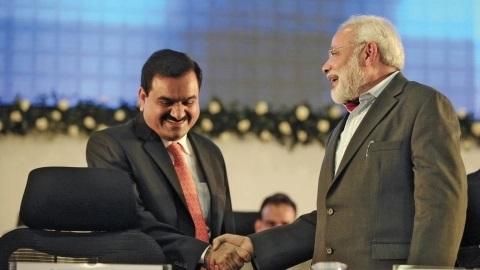Report Raises Questions About Adani Group’s Rapid Growth in Modi Years

Image Courtesy: The Wire
A Scroll.in special investigation report has traced how the Gujarat-based Adani Group expanded and funded its businesses in India in the last five years under the Narendra Modi regime, while raising unanswered questions concerning the group’s growth.
The Adani group, the report says, “not only is it the country’s largest private port operator, coal importer, coal miner, private power producer, city gas distributor and importer of edible oils, it has also expanded into airports, urban water management, small and medium sector lending, power transmission and distribution, data centres, aerospace and defence”.
In September and October 2018, Modi government awarded 126 gas contracts, to firms to set up and operate piped natural gas stations and fuel stations across India. Adani group was the largest winner of the bidding process – winning 25 bids – 15 on its own and 10 in a joint venture with government-owned Indian Oil Corporation.
According to the Scroll.in, “These gas contracts are part of a larger pattern of growth for the Gautam Adani-led infrastructure conglomerate. One part of the expansion has come through acquisitions.”
While in 2013, Adani group had 44 projects in India, the number had grown to 92 by 2018. Between these years, the group entered new sectors, acquired multiple projects and also kept investing its existing businesses. “From its modest beginning, the group is now present in more than 260 cities across India,” the report quoted one group company’s spokesperson as saying.
The report argues that “this great burst of growth runs contrary to the pattern witnessed by other players in the field”.
The last four years have been difficult for the country’s infrastructure sector. “Hit by policy shocks like the Supreme Court’s decision in September 2014 to cancel the allocation of over 200 coal block allocations to power and steel firms, depriving them of cheap sources of fuel, many debt-strapped Indian business groups have put infrastructure assets on sale to avoid getting dragged into insolvency proceedings. International sovereign and pension funds are vying to pick up these assets.”
The report explains: “At the same time, the Indian government is auctioning a large number of existing and proposed infrastructure projects in sectors like highways and gas distribution. Not only has the Adani group escaped the headwinds that hampered its peers in the infrastructure sector, it has bought assets both from them and the government.”
How does the group fund this expansion?
In 2018, the group bought “Reliance’s power transmission business for Rs 12,300 crore, GMR Chhattisgarh for Rs 5,200 crore, Katupalli port for Rs 1,950 crore, and paid Rs 228 crore for the power transmission line between Bikaner and Sikar. This adds up to Rs 19,687 crore on acquisitions alone”.
It also committed to expenditure on new projects. “Each gas contract translates into an investment of Rs 1,200 crore-Rs 1,500 crore, said the Swan Energy executive. For 25 contracts, the most conservative estimate shows the group having to make an outlay of Rs 24,000 crore.”
“Similarly, the group announced an investment of Rs 70,000 crore over the next 20 years for its data centres in Andhra Pradesh and another Rs 53,000 crore in Katupalli port. Apart from these, the group also made investments in its existing businesses such as the Rs 500 crore it infused into Adani Capital and Rs 940 crore in its troubled Australian coal project. In addition, it ensured that none of its struggling businesses defaulted on payments,” said the report.
While the Adani group remained unanswered to the Scroll.in’s questions on investments, in 2018, between acquisitions, new businesses and existing businesses, the group had announced future expenditure of Rs 1,67,000 crore.
Scroll.in examined financial statements of several Adani Group companies including the group’s six listed companies: Adani Enterprises, Adani Ports and SEZ, Adani Power, Adani Transmission, Adani Green Energy and Adani Gas and the financials of the unlisted group companies filed with the Registrar of Companies, in the last few years.
The study found that the group is increasingly raising money from overseas and within India, in the form of bank loans, borrowing against shares and pledging assets.
The report lists six ways in which the group raises the money: 1.Companies buy shares in other group firms, even if they are in unrelated businesses, 2. Companies use borrowed funds to buy equity in other group firms, 3.Group companies lend to each other, 4. Some of the money from step-down subsidiaries goes to other holding companies, 5. Group companies prop up struggling firms and 6. The Adani Group raises debt and equity from overseas.
By such practices, a few Adani Group subsidiaries, despite recurring losses, had never defaulted on debt repayments.
Scroll.in quoted one person familiar with the group’s finances as saying: “Adani Enterprises now deals mostly with coal but also functions as an incubator for the group’s ventures.” According to him/her, while the group’s other listed companies invest only in their subsidiaries, subsidiaries of Adani Enterprises invest across the group. “Adani Tradeline, Parsa Kente Rail Infra, etc. – are all subsidiaries of Adani Enterprises.”
Adani Infra, a subsidiary of Adani Enterprises, raises a high quantity of funds for the group. “In 2017-18, it raised debt worth Rs 15,048 crore. These loans were raised by offering shares in group companies as security cover,” finds the report.
“In most companies, the ratio between debt and equity is 1:3 or 1:4. If a sector is low risk, companies might be able to raise debt which is 10-12 times equity, said the former board member. But in the case of Adani Infra, it is 1:107.” For instance, in 2017-18, Adani Infra had Rs 84.87 crore in equity but Rs 9,008.5 crore of total borrowings.
Between 2014 and 2018, Adani Transmission, Adani Enterprises, Adani Infra and Adani Agrifresh saw multiple transfers of money between themselves in the form of loans and repayments. The scrutiny of the finances revealed that transactions among the group companies helped them in their enormous growth. Although Adani Power was struggling between 2013 and 2018, such transactions within the group helped the company to meet its debt obligations.
“Adani Group is willing to leverage its balance sheet much more than others. Adani subsidiaries with better debt/equity numbers are borrowing from banks and investing in their stressed sister companies – as debt or equity,” said one senior executive at credit rating firm Credit Suisse to Scroll.in.
The report ends by pointing out two factors working in favour of Adani Group. The first is “its perceived proximity to political power. It has enabled the group to take bets its peers could not. This is seen in the operations of Adani’s power plant in Mundra. Even as other debt-strapped power companies put their power projects on sale, the Adani group doubled down and kept infusing cash into Mundra.” The second factor is scale. “Not only is it able to cross-subsidise its units, in the last five years, it has emerged as the biggest player in Indian infrastructure’s public utility sector.”
According to the report, for many experts, “the potential consequences of having a financially overleveraged monolith dominate India’s public utility infrastructure are worrying.”
Also read: Supreme Court to Look Into Adani’s ‘Coal Import Scam’
Get the latest reports & analysis with people's perspective on Protests, movements & deep analytical videos, discussions of the current affairs in your Telegram app. Subscribe to NewsClick's Telegram channel & get Real-Time updates on stories, as they get published on our website.
























